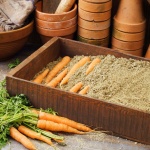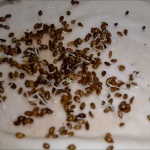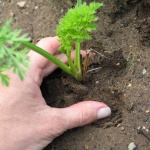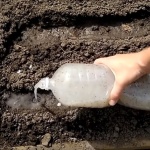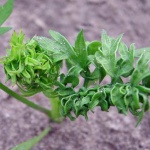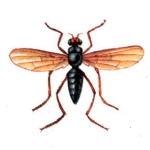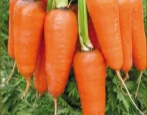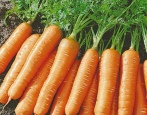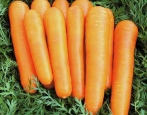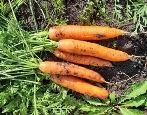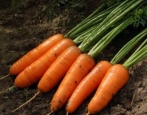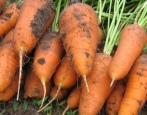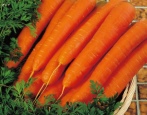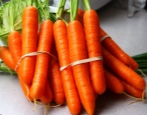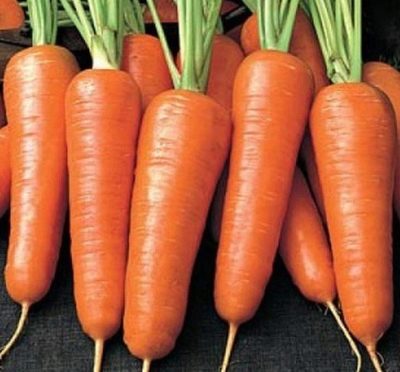
- Authors: Ugarova S.V.
- Year of approval: 2007
- Appointment: for fresh consumption, for canning, for freezing, for making juice
- Leaf rosette shape: semi-spreading
- Leaves: medium, green, medium dissected
- Weight, g: 90-190
- The form : cylindrical with blunt tip
- Taste qualities: good and excellent
- Composition : dry matter 11.1-14.1%, total sugar 6.1-8.9%, carotene up to 17.4 mg per 100 g of raw matter
- Ripening terms: mid-season
Sentyabrina is a carrot variety bred by Russian specialists and approved for use in 2007. This variety has its own characteristics and is very popular with gardeners.
Description of the variety
This is a high-yielding variety, which is characterized by high marketability (77-94%), excellent keeping quality and the ability to store all winter without loss of marketability and taste.
Characteristics of the appearance of the plant and root crops
The rosette is semi-spreading, has green, medium-sized leaves. The root crop is distinguished by a cylindrical shape with a blunt tip, its length is up to 17 cm, and its weight is 90-190 grams. The skin and core of the tubers are orange, the surface is smooth.
Purpose and taste of tubers
The flesh of Sentyabrina is sweet, tender, it contains a large amount of useful carotene, part of which is retained even during heat treatment, and even more so when frozen. This carrot can be used fresh, for cooking frying, carrot juice, for canning.
Maturation
The first crop is usually harvested 120 days after sowing, which is typical for mid-ripening varieties.
Yield
The variety has a high yield, on average from each hectare it can produce 235-540 centners of tubers. It is recommended not to delay harvesting, as the roots of this variety are prone to cracking. For extended winter storage, choose whole, healthy tubers, and process damaged carrots right away. To preserve the harvest, mix vegetables with clean dry sand in a box, and put the box in the basement.
Growing and care
Sowing is carried out around mid-spring. Pay special attention to the choice of the site. This carrot loves sunny places, and as for the composition of the soil, it will feel more comfortable in loam or sandy loam. Sowing is carried out in pre-prepared moistened grooves, the seeds are buried by about 3 cm.
Do not plant the plants in a dense row, otherwise it will negatively affect the quality and quantity of tubers. If the plantings are thickened, then thin them during the growing process. There are several opinions about thinning, but the more common is the scheme of 25-30 plants per meter, or 4-5 cm between each two copies. Next, the planted planting material should be sprinkled with soil and wait for shoots.
Follow-up care consists of watering, fertilizing and cultivating the land. Keep in mind that this crop does not require a lot of fertilizing, 2-3 fertilizers per season are enough for it. The plant reacts poorly to an excess of organic compounds. The fact is that when receiving organic matter, Sentyabrina begins to devote all her strength to the formation of green mass, but she does not have the strength to grow the root crop, therefore, when using organic matter, a high-quality volumetric crop can not be expected.
This variety tolerates dry summers well, but it will not refuse systematic watering. It is recommended to moisturize the bed often, but in a small amount. After watering, it is necessary to loosen the soil and remove weeds, which prevent the free penetration of moisture and oxygen to the roots.
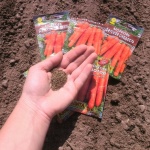
Carrots are one of the most unpretentious crops in terms of growing conditions; they can endure a short drought and a short cold snap. However, to get tasty and large root crops, you should adhere to the basic rules for planting carrots.
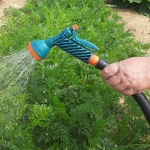

Disease and pest resistance
Sentyabrina is distinguished by strong immunity to diseases, but it can be affected by fungal diseases. As for insects, its main enemies are slugs and aphids. To fight fungi, use the "Guapsin" and "Mikosan" products. If root rot occurs, use Trichodermin. For protection against aphids, "Verticillin" has proven itself well.
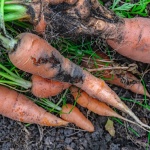
Carrots grow in almost any garden. There is an opinion that this culture is very resistant to all kinds of diseases and pests, but this is not the case. Without proper care, carrots become susceptible to all kinds of infections and are affected by harmful insects.
Review overview
This variety attracts most gardeners with its high productivity, versatility in use and the possibility of long-term storage. However, among the features of the Sentyabrina variety, summer residents also note disadvantages, namely: a tendency to cracking in case of untimely harvesting.

